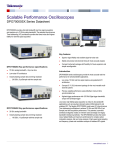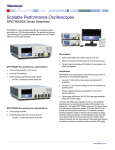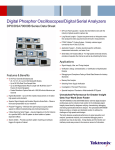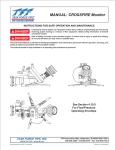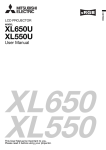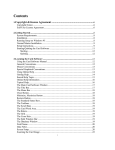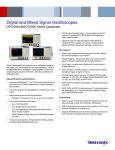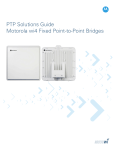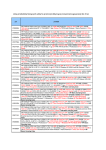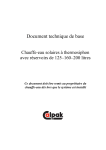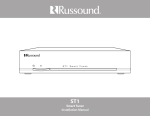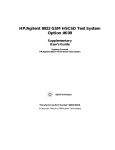Download DPO70000SX Scalable Performance Oscilloscope
Transcript
Scalable Performance Oscilloscopes DPO70000SX Series Datasheet DPO70000SX provides ultra-high bandwidth real time signal acquisition and analysis up to 70 GHz analog bandwidth. The patented Asynchronous Time Interleaving (ATI) architecture provides the lowest noise and highest fidelity for real time signal acquisition. Superior signal fidelity and excellent signal-to-noise ratio Stable and precise multi-channel timing for most accurate analysis Compact instrument package with flexibility for future expansion and simple reconfiguration Low-noise, high fidelity signal acquisition is critical in ultra-bandwidth applications such as long-haul coherent optical, 400G datacomm and wideband RF. The flagship DPO77002SX model uses ATI (Asynchronous Time Interleaving) architecture to achieve 70 GHz and 200 GS/s (5 ps/ Sample) real time acquisition performance. This patented, symmetric architecture elegantly creates an inherent noise advantage over legacy bandwidth interleaving methods. The DPO70000SX provides the lowest noise, highest fidelity and maximum performance for complex optical modulation analysis, jitter and noise analysis of high speed serial signaling and frequency, phase and modulation analysis of wideband RF signals. Introduction DPO70000SX-series oscilloscopes provide the most accurate real time performance for ultra-bandwidth applications. Low noise, 70 GHz real time signal capture using patented ATI architecture Compact 5 ¼" (3U) instrument package for the most versatile multichannel systems Precise, scalable performance using UltraSync multi-unit time synchronization bus Highest trigger performance with >25 GHz Edge trigger bandwidth, unique new Envelope trigger www.tektronix.com 1 Datasheet 2 www.tektronix.com Scalable Performance Oscilloscopes www.tektronix.com 3 Datasheet ATI architecture delivers lowest noise Current real time scope solutions for digitizing ultra-high bandwidth signals distribute signal energy to two digitizing paths then use DSP to reconstruct the input signal. Unlike legacy schemes, Tektronix' unique ATI architecture provides a symmetric technique that delivers all signal energy to both digitizing paths resulting in an inherent noise advantage. The diagram shows how an input signal enters the ATI ASIC where it is sampled and alternately delivered to each digitizing subsystem. The sample clock runs at 75 GHz and effectively folds the spectrum of the input signal about 37.5 GHz prior to digitizing. Each digitizing path operates at 100 GS/s and the folded spectrum is band limited to <40 GHz to meet Nyquist criteria. The alternating phase of the sampler has the effect of inverting signal phase 180° in one digitizing path, which provides significant benefit in reconstructing the final digitized signal. DPO77002SX vs. other vendor's 63 GHz model: Baseline noise % of FS vs. mVFS setting, with trace centered, at 60 GHz BW, maximum sample rate setting (200 GS/s or 160 GS/s) JNF performance An all-new master sample clock design which provides the remarkably low sample clock jitter of 65fsRMS, combined with the very low noise performance achieved with ATI, allows the DPO77002SX to reach new levels of jitter noise floor performance. The JNF at 300 mVFS is a mere 123 fsRMS, which even rivals lower bandwidth instruments. With two copies of the entire signal energy digitized, the signal spectra are "unfolded" using a DSP equivalent of the sampling process and combined to reproduce the input signal. Because two copies of the signal are being combined the process effectively averages them together, reducing random noise. Phase-inversion introduced by the sampling process causes intermediate frequency components to directly cancel one another, simplifying reconstruction and calibration. Thus, ATI architecture provides an inherent SNR advantage over legacy digital-bandwidth interleaving techniques. These techniques immediately split an input signal into upper and lower bands of frequencies. This divides the power and the upper frequency band must be mixed down prior to digitizing while the lower band is directly digitized. This asymmetric approach can make signal reconstruction and calibration more difficult and lead to errors in pass-band frequency or phase response. The division of power removes the opportunity to reduce signal noise. ATI alleviates these issues by using a unique symmetric architecture. A comparison of baseline noise between the Tektronix DPO77002SX and another vendor's 63 GHz model, with both instruments set to 60 GHz bandwidth, demonstrates the effectiveness of ATI at providing the lowest noise acquisition. 4 www.tektronix.com The figure shows jitter analysis of 60 GHz sine wave applied to the ATI input. The result shows a clean eye with random jitter RJ <80 fsRMS. Scalable Performance Oscilloscopes Compact ultra-performance oscilloscope DPO70000SX-series models establish a unique compact oscilloscope package that enables unprecedented workspace efficiency and mounting versatility. The SX-series provides a differentiated approach to ultrabandwidth real time acquisition that aligns with user trends toward large external monitors, higher degrees of automation and increased separation of data collection and data analysis workspaces. Stand-alone DPO70000SX compact models provide functionality equivalent to their bench counterparts (DPO70000DX) at half the height through addition of external display, keyboard and mouse. SX-series models can host Advanced Analysis software and be automated using internal or external control just as their bench counterparts. The DPO77002SX 70 GHz ATI Performance Oscilloscope provides one channel at 70 GHz, 200 GS/s acquisition performance or two channels at 33 GHz, 100 GS/s acquisition. The instrument includes a 70 GHz, 1.85 mm low-noise ATI input channel as well as general purpose TekConnect 2.92 mm inputs for versatile probing and signal conditioning options to 33 GHz. Optimal usability Less than half the height of bench models DPO70000SX-series instruments are contained in a 5 ¼" (3U) package that optimizes space usage and enables the most versatile range of mounting configurations. Two DPO70000SX instruments stack in less height than similar-class bench instruments, yet achieve higher measurement performance. Complete standalone oscilloscope Though compact, SX-series models provide full standalone oscilloscope functionality and performance. They can directly host Tektronix' Advanced Analysis applications for tasks such as jitter, noise, optical modulation or spectral analysis and do not require a separate processor or control unit. 2 x 70 GHz, 4 x 33 GHz configuration with monitor and auxiliary front panel The DPO73304SX model provides two channels at 33 GHz, 100 GS/s acquisition or four channels at 23 GHz, 50 GS/s real time acquisition performance. This model provides acquisition performance similar to the DPO73304DX bench model, but in the new compact instrument formfactor. All models in the DPO70000SX-series achieve the highest level of trigger performance available in real time oscilloscopes, >25 GHz edge trigger performance and <40 ps glitch trigger performance. An innovative new Window trigger type enables triggering on the envelope of RF signal bursts with time-qualification to discriminate envelope width. Industry-leading pulse-width timer performance enables the most precise discrimination of specific bit-widths in high speed serial data streams and detection of "runt" pulses in the midst of pseudo-random signaling. The DPO70000SX-series Auxiliary Trigger input provides low-jitter edge triggering and uses TekConnect accessories for a wide variety of signal conditioning solutions. Familiar scope controls where you want them The DPO7AFP Auxiliary Front Panel is a valuable usability accessory that compliments the compact instrument package by enabling users to operate with familiar controls without requiring access to the front of an instrument. The Auxiliary Front Panel provides the same control set embedded in DPO/ DSA/MSO/7000/70000 bench instruments as a separately packaged USB peripheral. This accessory enhances usability even when the instrument front panel may be obscured due to mounting location. www.tektronix.com 5 Datasheet The Trigger bus provides Run-Stop control for all members of a multiunit configuration and enables the trigger source to be from a Master or Extension unit. Control & data transfer from Extension units to the Master are managed with a PCIe, Gen 2, x4 link capable of 2 GB/s data transfer rate. Remote desktop operation As with current bench-model DPO /MSO70000-series instruments, DPO70000SX models can be operated remotely over a network using Windows® Remote Desktop. Use the Windows Remote Desktop utility to access your oscilloscope from across the lab or across the globe. Precision synchronization for multi-unit systems DPO70000SX-series instruments include the Tektronix UltraSync multi-unit time synchronization bus. UltraSync is used to synchronize sample clock, trigger and run-stop control across multiple units with performance equivalent to that found in monolithic scopes. UltraSync cables are available in 1 meter and 2 meter length to maximize configuration and layout versatility while preserving timing integrity of a multi-unit system. When operating in a multi-unit instrument configuration, one DPO70000SX has the role of Master, controlling one or more units operating in Extension mode. Any DPO70000SX model can operate as a standalone oscilloscope or serve as Master or Extension in a multi-unit configuration. Roles are determined by UltraSync cabling and no additional elements are needed. This allows users to decouple multi-unit configurations at any time and operate instruments in a standalone fashion without requiring a control unit or other accessories. Or, standalone units can be easily combined by simply adding UltraSync cables between Master and Extension. During startup of a multi-unit configuration a Configuration Manager application validates Master-Extension cabling and provides graphical feedback if elements are missing or misconfigured. Following validation, the system presents the TekScope user interface where waveforms from Master and Extension units are gathered for display and analysis using built-in features and Advanced Analysis applications. The UltraSync bus consists of three elements, each providing an important element of precise multi-unit operation: UltraSync includes a 12.5 GHz Sample Clock Reference signal sourced by the Master and used by each Extension to synchronize sample placement in the digitizing process. Scalable performance and versatile configurations DPO70000SX multi-unit modes enable a variety of extended performance and increased channel-count configurations. Master-Extension configurations provide additional input channels synchronized to the same degree of precision as internal channels and controlled from a single user interface as an interactive instrument or programming interface in automated applications. 6 www.tektronix.com Scalable Performance Oscilloscopes This scalable approach to performance allows users to purchase performance suitable for today's requirements, such as four channels of 33 GHz, 100 GS/s acquisition while also having two channels with 70 GHz, 200 GS/s performance suitable for next-generation designs. Subsequently, two additional units can be added for a total of four channels at 70 GHz, 200 GS/s. Units in this four-unit configuration can be separately deployed as pairs or standalone units at any time to meet other test demands. Another important aspect of skew is how the phase relationship between two channels varies with changing frequency (group delay effects). The following plot compares the performance of a DPS77004SX 70 GHz twounit system against the performance of another vendor's 63 GHz frequency-interleaved channels. What you see here is that the UltraSync two-channel skew performance dramatically surpasses the performance of a another vendor's single 63 GHz model containing two channels. The DPO77002SX also offers a unique value proposition in single-channel 70 GHz, 200 GS/s applications such as RF analysis or pulsed laser studies. In these cases a user can purchase a single unit for 70 GHz channel performance along with two channels at 33 GHz. Additional units can be purchased at a later time and combined using UltraSync if higher channel count is needed. The following multi-unit configurations are supported: 2 DPO77002SX: 2 Ch @ 70 GHz, 200 GS/s or 4 Ch @ 33 GHz, 100 GS/s 4 DPO77002SX: 4 Ch @ 70 GHz, 200 GS/s or 4 Ch 1 @ 33 GHz, 100 GS/s 2 DPO75902SX: 2 Ch @ 59 GHz, 200 GS/s or 4 Ch @ 33 GHz, 100 GS/s 4 DPO75902SX: 4 Ch @ 59 GHz, 200 GS/s or 4 Ch 1 @ 33 GHz, 100 GS/s 2 DPO75002SX: 2 Ch @ 50 GHz, 200 GS/s or 4 Ch @ 33 GHz, 100 GS/s Channel skew vs. Frequency comparison between DPO77002SX system and other vendor's 63 GHz model. 4 DPO75002SX: 4 Ch @ 50 GHz, 200 GS/s or 4 Ch 1 @ 33 GHz, 100 GS/s 2 DPO73304SX: 4 Ch @ 33 GHz, 100 GS/s or 4 Ch 1 @ 23 GHz, 50 GS/s 2 DPO72304SX: 4 Ch @ 23 GHz, 100 GS/s or 4 Ch 1 @ 23 GHz, 50 GS/s Skew Stability UltraSync provides outstanding integration and time alignment between units in a multi-unit stack. Once channels have been deskewed in a multiunit stack, skew is very stable over time and temperature. The specification for skew stability is ≤250 fsRMS. The following DPO77002SX skew measurement plot shows that even when including the startup temperature stabilization period (approximately 1 hour), the pk-pk variation is about 400 fs, and is about 350 fs pk-pk after the 1-hour warm-up period. This plot also shows exceptional consistency over this 12-hour data collection. Short signal path Minimizing input signal path length is especially important when working at 70 GHz ultra-high bandwidth. The compact nature of DPO70000SX creates more versatile mounting options when co-locating instrument and device under test (DUT). Options such as the Auxiliary Front Panel and Remote Desktop connection allow further flexibility by eliminating the need for direct access to the instrument front panel once connected. As a result, the SXseries enables the broadest range of options when dealing with a variety of DUT configurations as compared to classic bench instruments. Input signal path length may be minimized in multi-unit configurations by inverting one unit of a pair. The low, central location of the 70 GHz ATI input provides very small input connector spacing when operating units in this configuration. Instruments can also be arranged at various angles to suit DUT layout, such as at right angles for card-and-backplane situation or face-to-face around a small DUT. Layouts such as this create the shortest input signal path and maximize SNR. In addition, effects of signal path elements such as cables and adapters can be characterized and removed using the Serial Data Link Analysis application to obtain the best analysis results and insight. Change in channel-to-channel skew of DPO77002SX system over time. 1 Maximum of 4 channels displayed on-screen. Access to additional channels data available through program interface. www.tektronix.com 7 Datasheet Applications Coherent optical modulation analysis Tektronix DPO70000SX oscilloscopes are ideal for modulation format analysis of 400 Gb/s and Terabit-based coherent optical networking systems. The unique architecture enables scalability to grow instrument performance by adding channels or more bandwidth; to test 100 G cost effectively now and expand into 400 G or 1 Terabit later. The DPO70000SX low profile reduces concerns of signal loss in system connectivity on your coherent measurements by placing the Optical Receiver as close as possible to the instrument's input channel. 70 GHz Bandwidth on 4 Channels for 1 Terabit/s systems Industry-best lowest noise for low EVM 200 GS/s sampling on 4 channels for phase tracking Compact form factor with scalability for channel & bandwidth Customizable DSP for unique analysis needs PAM4 and NRZ datacom measurements More accurate modulation analysis starts with a lower Error Vector Magnitude (EVM) floor in the instrument. The DPO70000SX Oscilloscope utilizes ATI technology to provide the industry's lowest noise floor supporting these measurements. In addition, the system is achieving four channels of full 70 GHz Bandwidth at 200 GS/s per channel, providing a very rich analysis environment. When used in conjunction with the OM4524 Optical Modulation Receiver, optical system research engineers can customize their DSP analysis and visualization for non-standard modulation techniques using easy customer-specific implementations with extensive customizable analysis SW that leverages Matlab™. 8 www.tektronix.com As datacom networks increase their throughput, the DPO70000SX is ready to perform standards validation for many of today's 25/28 G industry standards (see chart below). With 50 GHz and 70 GHz models featuring the low-noise ATI architecture; the DPO70000SX, combined with DPOJET Jitter & Noise Analysis and the SDLA Serial Data Link Analysis tools, can perform accurate de-embedding and eye diagram evaluation on many of these key standards. Scalable Performance Oscilloscopes RF With its low noise and flat frequency response to 70 GHz, the DPO70000SX opens opportunities for measurement and analysis of wideband RF signals. SignalVu® vector signal analysis – When vector signal analysis of RF or baseband signals are needed, the optional SignalVu application enables measurements in multiple domains (frequency, time, phase, modulation) simultaneously. SignalVu measurements are fully correlated with the scope's time domain acquisition and triggering. Time domain events, such as commands to an RF subsystem, can be used as trigger events, while the subsystem's RF signal can be seen in the frequency domain. With 400 G networking, new serial data transmission speeds will reach 56 Gb/s per channel, making NRZ signaling techniques ineffective, leading to bandwidth efficient PAM4 (4 level pulse amplitude modulation). Accurate PAM4 validation is best conducted using the DPO70000SX Series with its industry-leading low noise ATI technology to achieve good effective bits performance on measurement results. For analysis of PAM4, the DPO70000SX Option PAM4 provides built-in software clock recovery, multi-level eye diagram plots and unique report tables for effective measurements as show below. In addition to spectrum analysis, spectrograms display both frequency and amplitude changes over time. Time-correlated measurements can be made across the frequency, phase, amplitude, and modulation domains. This is ideal for signal analysis that includes frequency hopping, pulse characteristics, modulation switching, settling time, bandwidth changes, and intermittent signals. SignalVu can process RF, I and Q, and differential I and Q signals from any oscilloscope inputs. Math functions applied by the oscilloscope are also used by SignalVu allowing users to apply custom filtering prior to vector signal analysis. The Microsoft Windows environment makes the use of this multi-domain analysis even easier with an unlimited number of analysis windows, all time-correlated, to provide deeper insight into signal behavior. With a user interface that adapts to your preferences (keyboard, front panel, touch screen, and mouse), SignalVu is easy to apply for both first-time users and experienced hands. Time-correlated, multi-domain view provides a new level of insight into design or operational problems not possible with conventional analysis solutions. Here, the hop patterns of a narrowband signal can be observed using Spectrogram (lower left) and its hop characteristics can be precisely measured with Frequency vs Time display (upper left). The time and frequency responses can be observed in the two right-hand views as the signal hops from one frequency to the next. Built-in clock recovery for PAM4 and NRZ-based signals up to 140 Gb/s Fine timing resolution with up to 200 GS/s sampling on each differential channel Debug edge timing using 25 GHz hardware trigger system www.tektronix.com 9 Datasheet Radar and high frequency-based analysis – The low-noise, high bandwidth DPO70000SX Series Oscilloscope is ideal for high frequency FFT-based measurement analysis. When combined with the powerful SignalVu software analysis option, the DPO70000SX instrument provides FFT (fast fourier transform) measurement capability up to 70 GHz. With its scalable instrument architecture, RF engineers can obtain a single channel unit for RF input-only measurements and grow to multi-unit configurations for comprehensive RF system validation. Examples of high-frequency RF measurements with the DPO70000SX include: Options tailored for your wideband applications – SignalVu vector signal analysis software offers options to meet your specific application, whether it be wideband radar characterization, broadband satellite, or spectrum management. SignalVu Essentials (Opt. SVE) provides the fundamental capability for all measurements and is required for pulse analysis (Opt. SVP), settling time (Opt. SVT), digital modulation analysis (Opt. SVM), flexible OFDM analysis (Opt. SVO), and AM/FM/PM Modulation and Audio Measurements (Opt. SVA). Wideband satellite and point-to-point microwave links can be directly observed with SignalVu analysis software. Chirp Linearity measurements on Radar signals (see below figure) Wireless measurements on IEEE802.11ad e.g. (60.48 GHz carrier frequency) Monitor & debug satellite communications over K-Band (20-40 GHz) General Purpose Digital Modulation Analysis (Opt. SVM) used to demodulating a 16QAM backhaul link running at 312.5 MS/s. Advanced analysis Once low-noise waveform data is captured by the 70 GHz DPO70000SX, SignalVu can be used to demodulate the signal, and display a constellation diagram and Error Vector Magnitude (EVM) measurement and other needed measurements. SignalVu also provides detailed analysis in multiple domains as additional options, such as pulse analysis and settling time for Radar systems work, digital modulation analysis and flexible OFDM analysis for emerging modulation standards, as well as AM/FM/PM modulation and audio measurements for lower bandwidth requirements. Industry low-noise enables low EVM floor 70 GHz provides wide dynamic range and accurate chirp linearity Integrated FFT & Phase Plot creation provides fast, accurate frequency domain measurements 10 www.tektronix.com DPOJET Comprehensive Jitter and Noise Analysis DPOJET provides engineers the highest measurement sensitivity and accuracy available in real-time instruments. With comprehensive jitter and eye-diagram analysis and decomposition algorithms DPOJET simplifies discovering signal integrity concerns and jitter and their related sources in today's high-speed serial, digital, and communication system designs. Scalable Performance Oscilloscopes DPOJET Jitter and Eye Diagram Analysis - Simplify identifying signal integrity issues, jitter, and their related sources. Noise analysis with DPOJET (Opt. DJAN) Jitter essentials, advanced analysis and custom extensions – DPOJET Essentials is standard on the DPO70000SX Series with the DPOJET advanced version available as an option. Application-specific measurement packages are also available that extend DPOJET and perform the extensive set of tests required by industry standard groups. SDLA signal path de-embed and custom filters Acceleration of signaling speeds and shrinking geometries create several challenges for next generation multi-gigabit designs and test methodologies. Designs are evolving to address these challenges with advanced equalization techniques at the transmitter and receiver. Smaller form factors make signal access more difficult, resulting in non-ideal probing points. This can lead to loss and reflections on the acquired signal due to impedance discontinuities that are not present at the ideal measurement location. The advanced techniques employed by the designs call for advanced measurement solutions. The challenge begins with the signal acquisition; capturing a signal through cables, probes and fixtures distort the signal shape. SDLA Visualizer allows you to de-embed the effects (reflections, insertion loss, and cross coupling) of the measurement circuit (cables, probes, and fixtures) from the waveform while taking into account the transmitter output and receiver input impedance. Deembedding these effects improves the accuracy of measurements and can make the difference between passing or failing a test. Signal path equalization – Using the optional Serial Data Link Analysis Visualizer (SDLA64) application, you can gain further insight into serial data links with the capability to emulate the serial data channel from its Sparameters, remove reflections, cross- coupling, and loss caused by fixtures, cables, or probes, and open closed eyes caused by channel effects using receiver equalization techniques, such as CTLE, DFE, FFE. IBIS-AMI models for silicon-specific receiver equalization can used to observe on-chip behavior. The eye diagrams below illustrate the correlated eye of a signal before a channel, after a channel, and after equalization. Eye closure due to channel effects have effectively been removed using SDLA and in this case the eye widths are within ~3 ps as shown in the eye diagram on the left and right hand sides. Custom filters – Create your own filters or use the filters provided standard with the DPO70000SX Series to enhance your ability to isolate or remove a component of your signal (noise or specific harmonics of the signal). These customizable FIR filters can be used to implement signalprocessing techniques, such as removing signal pre-emphasis or minimizing the effects of fixtures and cables connected to the device under test. Built-in analysis system – DPO70000SX includes a wide variety of builtin features for visualizing and measuring signal behaviors. Select from 54 automatic measurements using a graphical palette that logically organizes measurements into Amplitude, Time, Histogram, and Communications categories. Gather further insight into your measurement results with statistical data such as mean, min, max, standard deviation, and population. www.tektronix.com 11 Datasheet Define and apply math expressions to waveform data for on-screen results in terms that you can use. Access common waveform math functions with the touch of a button. Or, for advanced applications, create algebraic expressions consisting of live waveforms, reference waveforms, math functions, measurement values, scalars, and user-adjustable variables with an easy-to-use calculator-style editor. Custom math expressions with MATLAB Tektronix custom math expressions with MATLAB enable users to create MATLAB scripts that process live waveform data and return results into scope math traces. Extensions can also use MATLAB features to create specialized analysis and visualizations. With deep acquisition memory, margin testing can be done over many cycles and long duration trends in the data can be observed. Plus, data from the oscilloscope can be captured into Microsoft Excel using the unique Excel toolbar, and formatted into custom reports using the Word toolbar provided with the DPO70000SX Series. Counter timer The high resolution counter/timer is a new optional feature that is made possible by the new trigger system in the DPO70000SX series oscilloscopes. This is a precision frequency counter which provides frequency analysis up to 25 GHz, with up to 13 digits of resolution and 12 digits/second. Using the internal clock, this counter is accurate to better than 1 ppm. Higher accuracy is possible using a high precision external clock source. Because this measurement is made through the trigger system, it measures each and every cycle of the signal on a continuous basis during the trigger gate time, rather than making measurements on finite blocks of data through the normal acquisition channel. Pinpoint® trigger Whether you're trying to find a problem signal or need to isolate a section of a complex signal for further analysis, Tektronix Pinpoint® triggering provides the solution. Pinpoint® triggering allows selection of virtually all trigger types on both A and B trigger events delivering the full suite of advanced trigger types for finding sequential trigger events. Pinpoint® triggers provide trigger reset capabilities that begin the trigger sequence again after a specified time, state, or transition so that even events in the most complex signals can be captured. The DPO70000SX-series provides the highest trigger system performance available in a real time scope. The figure shows triggering on <50 ps bitwide runt pulses (fails to cross both thresholds within specified time) on 25.78 GBaud (100GbE) signaling. High system bandwidth and extreme trigger timer precision enable reliable capture of signal aberrations and efficient isolation of fault conditions. This feature provides the ability to make highly accurate clock stability measurements. In the screen capture shown, a deviation of 212 μHz of source wander is measured on an 8 GHz precision source. In this figure, the signal generator was set to 8.00000000001 GHz, and the scope measured precisely that amount. The timer allows precise measurements between trigger events with a 200 fs resolution, and can include time measurements from an A event to a B event, where A and B events can be any valid trigger mode (e.g. Glitch, Runt, Edge, etc). This feature is useful for measuring propagation delays, or analyzing anomaly occurrence rates. Three important distinctions between this counter/timer and conventional counter/timers are: > 25 GHz analog bandwidth Wide selection of high bandwidth scope probes available for the highest signal fidelity connection to the DUT Ability to view the waveform on-screen to insure the counter/timer is seeing a valid waveform, and that trigger levels are set appropriately for the waveform 12 www.tektronix.com In the next figure, pulse width discrimination is used to isolate pulses >40 ps and <60 ps wide, showing reliable capture of 50 ps pulses within a 20 Gbps PRBS11 sequence. Scalable Performance Oscilloscopes DPO70000SX includes a unique Envelope trigger mode that enables direct triggering on the envelope of a modulated carrier. Edge, Width and Timeout trigger types can be applied to a detected envelope to provide stable trigger on modulated bursts or discriminate bursts of a specific width. Carrier frequency can range from 500 MHz to 20 GHz to address a broad range of applications. The figure illustrates triggering on burst of specific width. Signal acquisition ATI input The DPO77002SX 70 GHz ATI input channel uses industry-standard 1.85 mm coaxial connection system specified to 67 GHz, with typical performance to 70 GHz. The instrument includes a calibration-grade 1.85 mm female-female adapter installed in the ATI input connector (male) to provide mechanical protection and gender selection. Instruments also include a static protection wrist strap, torque wrench and a set of backing wrenches to facilitate proper care and installation of signal path elements, ensuring optimal measurement performance. The 1.85 mm connection system is compatible with 2.4 mm (50 GHz) elements. TekConnect® inputs DPO70000SX models include the TekConnect signal interconnect system, offering unparalleled versatility with a wide array of accessory signal access and conditioning solutions. The TCA-292D TekConnect adapter provides 2.92 mm connection, 50 Ω coaxial environment to 33 GHz. Visual Trigger further extends the Pinpoint Triggering's capabilities, adding another level of trigger qualification to find important events in a wide variety of complex signals. Visual Trigger qualifies Pinpoint triggers by scanning through all waveform acquisitions and comparing them to onscreen areas (geometric shapes). Up to eight areas can be created using a mouse or touchscreen, and a variety of shapes (triangles, rectangles, hexagons, or trapezoids) can be used to specify the desired trigger behavior. Once shapes are created, they can be edited interactively to create ideal trigger conditions Probing and remote-head coaxial input Often the biggest challenge in debugging a system is getting access to required signals. Tektronix offers a wide array of probing solutions, including the P7600 and P7500 TriMode® probing system with bandwidths that are well matched to the DPO70000SX Series. This extensive probe offering is compatible with the TekConnect input available on all DPO70000SX models. The P7600 and P7500 TriMode® probes allow you to switch among differential, single-ended, and common-mode measurements without moving the probe from its connection points. The P7600 series combines low noise, 33 GHz bandwidth and the convenience of TriMode probing. Coaxial adapters enable the probe to act like a remote-head differential input channel for the oscilloscope which effectively doubles the number of differential signals a single oscilloscope can measure simultaneously. The P7500 Series offers probes with performance from 4 GHz to 25 GHz and offers several low-cost solder tips with quick connection features that allow moving the probe to various solder points fast and easy. High performance Auxiliary Trigger input DPO70000SX includes an Auxiliary Trigger input (TekConnect) suitable for high performance Edge triggering without consuming an acquisition channel. Aux trigger bandwidth is >10 GHz on the DPO70000SX-series with <1.5 psRMS jitter. Channel timing deskew All DPO70000SX models include differential fast-edge outputs matched to <1.6 ps on the front panel that provide a convenient source for aligning channel timing in a coaxial environment. Instruments include accessories to accomplish channel-to-channel timing deskew using the built-in source. Additional accessories can be purchased separately to accomplish even finer time alignment or deskew in a probe-based environment www.tektronix.com 13 Datasheet Bench or rack mount Rack environment DPO70000SX models are equally suited for bench and rack-mounted use and complimented with a number of elements to address specific environments. The DPO70000SX rack mount is a tray directly attached to the instrument. The tray occupies 1U rack height in addition to the 3U instrument and preserves a cooling channel for the unit. The rack mount also provides heavy-duty carry handles for transporting the instrument outside the rack environment. UltraSync cables are available in 1 meter and 2 meter lengths to enable configuration flexibility. The default 1 meter cable is suitable for typical twoand four-unit configurations with uniformly stacked instruments. The longer cable enables combinations operating at 90° to one another or face-to-face around a DUT. Cable length can be mixed in a configuration to suit application need and time de-skewed as a system to provide precise channel-to-channel time alignment. Instrument cases include recesses that align with feet such that stacked units mechanically engage one another for added stability. This feature also works in inverted-stacking configurations and mixed stacks that include an OM4000 Optical Receiver. Models include threaded holes for user-provided side brackets in cases where specific combinations are to be "locked" together. 14 www.tektronix.com The rack-mounting kit allows units to be mounted upright or inverted to minimize input cable length, just as when stacking on a bench. The DPO70000SX rack-mount tray can also house a front-mounted Solid State Drive (SSD) for easy access to instrument mass storage in a rack environment. Scalable Performance Oscilloscopes Specifications 2 Model overview 2 DPO77002SX/DPS77004SX DPO75902SX/DPS75904SX DPO75002SX/DPS75004SX ATI channel TekConnect channels ATI channel TekConnect channels ATI channel TekConnect channels Analog channels/bandwidth DPO77002SX 1 ch/67 GHz 1 ch/70 GHz (typical) DPS77004SX 2 ch/67 GHz 2 ch/70 GHz (typical) DPO77002SX 2 ch/33 GHz DPS77004SX 4 ch/33 GHz DPO75902SX 1 ch/59 GHz DPS75904SX 2 ch/59 GHz DPO75902SX 2 ch/33 GHz DPS75904SX 4 ch/33 GHz DPO75002SX 1 ch/50 GHz DPS75004SX 2 ch/50 GHz DPO75002SX 2 ch/33 GHz DPS75004SX 4 ch/33 GHz Sample rate per channel 200 GS/s 100 GS/s 200 GS/s 100 GS/s 200 GS/s 100 GS/s Rise time (typical) 10% to 90%: 5.6 ps 20% to 80%: 4.3 ps 10% to 90%: 13 ps 20% to 80%: 9 ps 10% to 90%: 6.8 ps 20% to 80%: 5.2 ps 10% to 90%: 13 ps 20% to 80%: 9 ps 10% to 90%: 7.8 ps 20% to 80%: 6 ps 10% to 90%: 13 ps 20% to 80%: 9 ps Vertical Noise (% of full scale), BWE on, max sample rate (typical) 0.83% of full scale 0.71% of full scale 0.83% of full scale 0.71% of full scale 0.83% of full scale 0.71% of full scale 0.75% of full scale @ 0 V offset (300 mVFS) 0.56% of full scale @ 0 V offset (500 mVFS) 0.75% of full scale @ 0 V offset (300 mVFS) 0.56% of full scale @ 0 V offset (500 mVFS) 0.75% of full scale @ 0 V offset (300 mVFS) 0.56% of full scale @ 0 V offset (500 mVFS) Record length, points (each channel, standard) 62.5 M 62.5 M 62.5 M 62.5 M 62.5 M 62.5 M Record length (each channel, Opt. 10XL) 125 M 125 M 125 M 125 M 125 M 125 M Record length (each channel, Opt. 20XL) 250 M 250 M 250 M 250 M 250 M 250 M Record length (each channel, Opt. 50XL) 1G 1G 1G 1G 1G 1G Timing resolution 5 ps (200 GS/s) 10 ps (100 GS/s) 5 ps (200 GS/s) 10 ps (100 GS/s) 5 ps (200 GS/s) 10 ps (100 GS/s) Duration at highest sample rate (Standard) 313 µs 625 µs 313 µs 625 µs 313 µs 625 µs Duration at highest sample rate (Opt. 10XL) 625 µs 1.25 ms 625 µs 1.25 ms 625 µs 1.25 ms Duration at highest sample rate (Opt. 20XL) 1.25 ms 2.5 ms 1.25 ms 2.5 ms 1.25 ms 2.5 ms Duration at highest sample rate (Opt. 50XL) 5.0 ms 10 ms 5.0 ms 10 ms 5.0 ms 10 ms All specifications are guaranteed unless noted otherwise. www.tektronix.com 15 Datasheet Model overview DPO73304SX/DPS73308SX DPO72304SX TekConnect channels TekConnect channels Analog channels/bandwidth DPO73304SX 2 ch/33GHz, 4 ch/23GHz DPS73304SX 4 ch/33GHz, 8 ch 3/23GHz DPO72304SX 4 ch/23GHz Sample rate per channel DPO73304SX 2 ch 100 GS/s, 4 ch 50 GS/s DPS73304SX 4 ch 100 GS/s, 8 ch 3 50 GS/s 2 ch 100 GS/s, 4 ch 50 GS/s Rise time (typical) 10% to 90%: 13 ps 20% to 80%: 9 ps 10% to 90%: 17 ps 20% to 80%: 13 ps Vertical Noise (% of full scale), BWE on, max sample rate (typical) 0.71% of full scale 0.71% of full scale 0.56% of full scale @ 0V offset (500 mVFS) 0.56% of full scale @ 0 V offset (500 mVFS) Record length, points (each channel, standard) 62.5 M 62.5 M Record length (each channel, Opt. 10XL) 125 M 125 M Record length (each channel, Opt. 20XL) 250 M 250 M Record length (each channel, Opt. 50XL) DPO73304SX 1 G on 2 ch, 500 M on 4 ch DPS73304SX 1 G on 2 ch each unit, 500 M on 4 ch each unit 1 G on 2 ch, 500 M on 4 ch Timing resolution 10 ps (100 GS/s) 10 ps (100 GS/s) Duration at highest sample rate (Standard) 625 µs 625 µs Duration at highest sample rate (Opt. 10XL) 1.25 ms 1.25 ms Duration at highest sample rate (Opt. 20XL) 2.5 ms 2.5 ms Duration at highest sample rate (Opt. 50XL) 10 ms 10 ms Vertical system - analog channels Input coupling TekConnect channels: Two modes: DC, 50 ohms to a programmable termination voltage; Ground. The termination can be connected to a DC voltage: ≤ 1.2 VFS settings: -3.5 V to 3.5 V, > 1.2 VFS settings: 0.0 V ATI channel: DC, 50 Ω. Input resistance ≤1.2 VFS settings 50 Ω ±3% at 18 to 28 ºC (64 to 82 ºF) 50 Ω ±4% over 5 to 45 ºC (45 to 113 ºF) >1.2 VFS settings 3 50 Ω ±4.4% over 5 to 45 ºC (45 to 113 ºF) Maximum of 4 channels displayed on-screen. Additional channels data available through program interface. 16 www.tektronix.com Scalable Performance Oscilloscopes Vertical system - analog channels Sensitivity range TekConnect channels 62.5 mVFS to 6 VFS ATI channel 100 mVFS to 300 mVFS. Maximum input voltage TekConnect channels: ≤1.2 VFS settings: ±1.5 V relative to the termination bias (30 mA maximum) ±5 V absolute maximum input >1.2 VFS settings: ±8 V. Limited by maximum Vterm current and the attenuator power rating at maximum temperature. ATI channel: ±0.75 Vpk Aux channel: ±5.0 Vpk Input termination voltage (VTerm) range, TekConnect channels ≤1.2 VFS settings: -3.5 V to +3.5 V >1.2 VFS settings: 0V Frequency response tolerance All modes, BWE on, 18 ºC to 28 ºC (typical) TekConnect channel: Step settings TekConnect channels: 77.5 mVFS, 151 mVFS, 302 mVFS, 605 mVFS, 1210 mVFS., 1620 mVFS, 3240 mVFS ±0.5 dB from DC to 50% of nominal BW ±1.5 dB from 50% to 80% of nominal BW All other gain settings: ±1.0 dB from DC to 50% of nominal BW ±2.0 dB from 50% to 80% of nominal BW ATI channel: All volts/div settings ±0.5 dB from DC to 20 GHz ±0.75 dB from >20 GHz to 30 GHz ±1.25 dB from >30 GHz to 68.5 GHz ±2 dB from >68.5 GHz to 69.5 GHz +2 / -3 dB at 70 GHz Bandwidth limit Depending on instrument model: 70 GHz to 1 GHz in 1 GHz steps, or 500 MHz; 5 GHz steps above 35 GHz Hardware-only bandwidth settings at 33 GHz available on non-ATI channels. No hardware-only settings available on ATI channel. Vertical resolution 8 bits, (11 bits with averaging) DC gain accuracy ± 2% www.tektronix.com 17 Datasheet Vertical system - analog channels Effective number of bits (typical). Average value from DC to full bandwidth of model. 70 GHz ATI Channel 4.6 bits at 250 mV FS, 200GS/s 59 GHz ATI Channel 4.8 bits at 250 mV FS, 200GS/s 50 GHz ATI Channel 5.0 bits at 250 mV FS, 200GS/s 33 GHz TekConnect Channels 5.0 bits at 500 mV FS, 100GS/s 23 GHz TekConnect Channels 5.4 bits at 500 mV FS, 100GS/s Offset range TekConnect channels ATI channel Full Scale voltage range Offset range 62.5 mVFS – 1.2 VFS ±3.4 V >1.2 VFS – 6 VFS ±6 V Full Scale voltage range Offset range 100 mVFS – 300 mVFS ±300 mV - (10 div × Volts/div) Full scale voltage range Offset accuracy 100 mVFS to 300 mVFS (ATI channel) 62.5 mVFS to 1.2 VFS (TekConnect channels) ±(0.4% | net offset | + 0.2% | net offset – Vterm setting | + 2.5 mV + 1% FS) >1.2 VFS to 6 VFS (TekConnect channels) ±(0.6% | net offset | + 13.4 mV + 1% FS) Offset accuracy Position range 18 www.tektronix.com ± 5 divisions Scalable Performance Oscilloscopes Vertical system - analog channels Channel-to-channel crosstalk (channel isolation), typical Input frequency range (up to the rated bandwidth). Assumes two channels with the same scale and bandwidth settings. The limits apply up to the bandwidth of the particular instrument. ATI models Specified channels Instrument frequency range Isolation ATI channels (isolation between any two DC to 70 GHz [or more] ATI channels in separate units), requires UltraSync 70 dB TekConnect channels in an ATI unit (isolation between channels 1 and 3) DC to 33 GHz 60 dB TekConnect channels to ATI channel (isolation between channels 1 and 3 to channel 2) DC to 4 GHz 55 dB >4 GHz to 10 GHz 45 dB >10 GHz to 20 GHz 35 dB >20 GHz to 30 GHz 30 dB >30 GHz to 33 GHz 27 dB DC to 3 GHz 55 dB >3 GHz to 12 GHz 40 dB >12 GHz to 33 GHz 30 dB >33 to 70 GHz 60 dB Specified channels Instrument frequency range Isolation Isolation between channels 1 or 2 and channels 3 or 4 DC to 33 GHz 60 dB Isolation between channels 1 and 2, or channels 3 and 4 DC to 2 GHz 60 dB >2 to 10 GHz 42 dB >10 to 20 GHz 35 dB >20 to 33 GHz 30 dB ATI channel to TekConnect (non-ATI) channels (isolation between channel 2 and channels 1 or 3) TekConnect models (non-ATI) Horizontal system Time base accuracy ±0.8 x 10-6 ±0.3 x 10-6 aging/year after first year when operated within 23°C ±5°C after 30 minute warm-up. Typical: ±0.1 x 10-6 initial accuracy after adjustment. Time base delay time range –5.0 ks to 1.0 ks Sample Clock Jitter (typical) <5 μs Duration: 65 fsRMS Trigger jitter (typical) 10 fs using enhanced trigger placement. www.tektronix.com 19 Datasheet Horizontal system Time/Div settings ATI channel (only sample rate is 200 GS/s) Max RT setting: 500 μs/div (with 1G RL, 50XL option) Min RT setting: 25 ps/div Max IT setting: 250 μs/div (with 1G RL, 50XL option) Min IT setting: 500 fs/div TekConnect channels (at max Max RT setting: 1 ms/div (with 1G RL, 50XL option) sample rate of 100 GS/s) Min RT setting: 50 ps/div 4 Max IT setting: 10 μs/div (with 1G RL, 50XL option) Min IT setting: 500 fs/div Delay between channels, BWE (typical) ≤ 500 fs between any two channels within the same box at any gain setting at 25 °C ±5 °C prior to any user adjustment. Manual adjustment available with 10 fs minimum resolution. Derate linearly to ≤ 3 ps at 5 °C and 45 °C. Channel skew stability, UltraSync (typical) ≤ 250 fsRMS between any two channels between instruments at any gain setting at 25 °C ±5 °C. Derate linearly to ≤ 3 ps at 5 °C and 45 °C. Channel-to-Channel deskew range ±75 ns Acquisition system Acquisition modes Sample Acquires and displays sampled values Average From 2 to 10,000 waveforms can be included in an average waveform Envelope From 1 to 2×109 waveforms included in min-max envelope Hi-Res Real-time boxcar averaging reduces random noise and increases resolution Peak detect Capture and display narrow glitches at all real-time sampling rates. Glitch widths: 1 ns at ≤125 MS/s; 1/sample rate at ≥250 MS/s FastAcq® (TekConnect channels only) FastAcq® optimizes the instrument for analysis of dynamic signals and capture of infrequent events, capturing >300,000 waveforms per second on all TekConnect channels simultaneously, standalone configuration only FastFrame™ Acquisition memory divided into segments; maximum trigger rate >310,000 waveforms per second. Time of arrival recorded with each event. Frame finder tool helps to visually identify transients. TekConnect channels only, standalone configuration only Roll mode Scrolls sequential waveform points across the display in a right-to-left rolling motion. Works at sample rates up to 10 MS/s with a maximum record length of 40 MS. TekConnect channels only, standalone configuration only Waveform database Accumulates waveform data providing a three-dimensional array of amplitude, time, and counts. TekConnect channels only, standalone configuration only Pinpoint® Trigger system Trigger sensitivity (typical) 4 Internal DC coupled A-Event trigger, B-Event trigger ≤ 5%FS from DC to 50 MHz ≤ 7.5%FS at 5 GHz ≤ 10%FS at 10 GHz ≤ 15%FS at 15 GHz ≤ 35%FS at 20 GHz ≤ 50%FS at 25 GHz Aux input 50 Ω (external trigger) Auxiliary input 100 mVpp from DC to 1 GHz 175 mVpp at 4 GHz 225 mVpp at 8 GHz 325 mVpp at 10 GHz 800 mVpp at 12 GHz Sample rate on TekConnect channels can be varied down to 3.125 samples/second, resulting in a max RT setting of 6.55 Ms/div, with a record length of 205 M (requires 250 M or higher RL, 20XL option) 20 www.tektronix.com Scalable Performance Oscilloscopes Pinpoint® Trigger system Edge trigger sensitivity, non-DCcoupled modes (typical) All sources, positive or negative edge, for vertical scale settings ≥10 mV/div and ≤1 V/div Trigger Coupling Sensitivity NOISE REJ 15%FS from DC to 50 MHz 22.5% at 5 GHz 30%FS at 10 GHz 45%FS at 15 GHz 100%FS at 20 GHz AC Same as DC-coupled limits for frequencies > 100 Hz, attenuates signals <100 Hz HF REJ Same as DC-coupled limits for frequencies < 20 kHz, attenuates signals > 20 kHz LF REJ Same as DC-coupled limits for frequencies > 200 kHz, attenuates signals < 200 kHz RF Minimum hysteresis / High sensitivity A TRIG TekConnect 2.5% FS from DC to 50 MHz 2.5% FS at 5 GHz 2.5% FS at 10 GHz 5% FS at 15 GHz 7.5% FS at 20 GHz 12.5% FS at 25 GHz B TRIG TekConnect 2.5% FS from DC to 50 MHz 2.5% FS at 5 GHz 2.5% FS at 10 GHz 5% FS at 15 GHz 7.5% FS at 20 GHz 20% FS at 25 GHz A TRIG ATI 2.5% FS from DC to 50 MHz 2.5% FS at 5 GHz 2.5% FS at 10 GHz 5% FS at 15 GHz 10% FS at 20 GHz 23.5% FS at 25 GHz B TRIG ATI 2.5% FS from DC to 50 MHz 2.5% FS at 5 GHz 2.5% FS at 10 GHz 5% FS at 15 GHz 10% FS at 20 GHz 22.5% FS at 25 GHz www.tektronix.com 21 Datasheet Pinpoint® Trigger system A-Event and delayed B-Event trigger types Standalone instrument DPO73304SX DPO72304SX DPO77002SX DPO75902SX DPO75002SX Trigger type TekConnect channel ATI channel TekConnect channel Edge X X X Glitch X X X Width X X X Runt X X X Window X X X Timeout X X X Period/Frequency X X X Envelope X X X Transition X X X Logic Pattern X X Setup/Hold X X Low speed serial X Logic state X Multi-unit configuration DPO73304SX DPO72304SX DPO77002SX DPO75902SX DPO75002SX Trigger type TekConnect channel ATI channel TekConnect channel Edge X X X Glitch X X X Width X X X X X Main trigger modes Auto, Normal, and Single Trigger sequences Main, Delayed by Time, Delayed by Events, Reset by Time, Reset by State, Reset by Transition. All sequences can include a separate horizontal delay after the trigger event to position the acquisition window in time Trigger coupling DC, AC (attenuates <100 Hz) HF Rej (attenuates >20 kHz) LF Rej (attenuates <200 kHz) Noise Reject (reduces sensitivity) RF coupling (increases trigger sensitivity and bandwidth at the highest operating frequencies) Variable A-Event trigger holdoff range 250 ns to 12 s + random holdoff Trigger level or threshold range 22 www.tektronix.com Trigger Source Range Ch1, 2, 3, or 4 Full scale Auxiliary input ±3.65 V Line 0 V, Not settable Scalable Performance Oscilloscopes Pinpoint® Trigger system Enhanced triggering Enhanced triggering corrects the difference in timing between the trigger path and the acquired data path (supports all Pinpoint trigger types on both A- and B-Events except pattern trigger); Default On (user-selectable); Not available in FastAcq mode. Line trigger Trigger on power line signal. Level fixed at 0 V. Visual Trigger Requires Option VET Max number of areas 8 Area shapes Rectangle, Triangle, Trapezoid, Hexagon, user defined shapes (can have >40 vertices) Compatibility Visual Trigger qualification is compatible with all trigger types and all trigger sequences Trigger types Trigger type Description Edge Positive or negative slope on any channel or front-panel auxiliary input. Coupling includes DC, AC, noise reject, HF reject, LF reject, and RF coupling. Frequency/Period Trigger on event that crosses threshold twice with same slope within or outside of selectable time limits. Slope may be positive, negative or either. Glitch Trigger on or reject glitches of positive, negative, or either polarity. Minimum glitch width is 40 ps (typical) with rearm time of 50 ps (<5 ns interval), 75 ps above 5 ns. Pattern Trigger when pattern goes false or stays true for specified period of time. Pattern (AND, OR, NAND, NOR) specified for four input channels. Runt Trigger on a pulse that crosses one threshold but fails to cross a second threshold before crossing the first again. Event can be time- or logic-qualified. Minimum runt width is 40 ps (typical) with rearm time of 50 ps Setup/Hold Trigger on violations of both setup time and hold time between clock and data present on any two input channels. State Any logical pattern of channels (1, 2, 3) clocked by edge on channel 4. Trigger on rising or falling clock edge. Timeout Trigger on an event which remains high, low, or either, for a specified time period. Selectable from 300 ps. Transition Trigger on pulse edge rates that are faster or slower than specified. Slope may be positive, negative, or either. Width Trigger on width of positive or negative pulse either within or out of selectable time limits (down to 40 ps). Window Trigger on an event that enters or exits a window defined by two user-adjustable thresholds. Event can be time or logic qualified. Visual Trigger Trigger when the Visual Trigger expression is satisfied. Envelope Qualification applied to Edge, Glitch, Width or Runt trigger such that trigger type is performed on the detected envelope of a modulated carrier. Carrier frequency 250 MHz to 15 GHz. Minimum burst width <20 ns, maximum gap between bursts <20 ns. Trigger mode Description Trigger Delay by Events 1 to 2 billion events. Trigger Delay by Time 3.2 ns to 3 million seconds. B-Event Scan B-Event Scan is an A to B trigger sequence that will trigger and capture burst event data of interest as defined in the B-Event Scan setup menu. Captured bits can be scanned in a sequential or randomized fashion, and alternatively the trigger can toggle between two successive B trigger events. Eye diagrams can be constructed with burst data acquired as a result of scanning B-Event. Trigger modes Trigger modes www.tektronix.com 23 Datasheet Waveform analysis Search and Mark Events Search and Mark Events Search for edges, glitches, or pulses of specified width. Any events found matching the search criteria are marked and placed in the Event table. The search can use positive/negative slopes or both on any channels. When an event of interest is found, other similar events can be found using "Mark All Trigger Events in Record" in the Pinpoint trigger control windows. The Event table summarizes all found events. All events are time stamped in reference to trigger position. Users can choose to stop acquisitions when an event is found. Waveform measurements Waveform measurements Automatic measurements 54, of which 8 can be displayed on-screen at any one time; measurement statistics, user-definable reference levels, measurement within gates isolating the specific occurrence within an acquisition to measure The DPOJET Jitter and Eye Analysis application offers additional automated and advanced measurements such as jitter. Amplitude related Amplitude, High, Low, Maximum, Minimum, Peak-to-Peak, Mean, Cycle Mean, RMS, Cycle RMS, Positive Overshoot, Negative Overshoot Time related Rise Time, Fall Time, Positive Width, Negative Width, Positive Duty Cycle, Negative Duty Cycle, Period, Frequency, Delay Combination Area, Cycle Area, Phase, Burst Width Histogram related Waveform Count, Hits in Box, Peak Hits, Median, Maximum, Minimum, Peak-to-Peak, Mean (μ), Standard Deviation (sigma), μ +1sigma, μ +2sigma, μ +3sigma Waveform processing/math Algebraic expressions Define extensive algebraic expressions including Waveforms, Scalars, User-adjustable Variables, and Results of Parametric Measurements e.g. (Integral (CH1 ‒ Mean(CH1)) × 1.414 × VAR1) Arithmetic Add, Subtract, Multiply, Divide Waveforms and Scalars Filtering function User-definable filters. Users specify a file containing the coefficients of the filter. Several example filter files are provided Frequency domain functions Spectral Magnitude and Phase, Real and Imaginary Spectra Mask function Generates a Waveform Database pixel map from a sample waveform. Sample count can be defined Math functions Average, Invert, Integrate, Differentiate, Square Root, Exponential, Log 10, Log e, Abs, Ceiling, Floor, Min, Max, Sin, Cos, Tan, ASin, ACos, ATan, Sinh, Cosh, Tanh Relational Boolean result of comparison >, <, ≥, ≤, ==, != Vertical units Magnitude: Linear, dB, dBm Phase: Degrees, radians, group delay IRE and mV units Window functions Rectangular, Hamming, Hanning, Kaiser-Bessel, Blackman-Harris, Gaussian, Flattop2, Tek Exponential Customized Functions using Math Plug-in Interface An interface is provided to allow users to create their own custom math functions in MATLAB or Visual Studio Display system Color palettes Normal, Green, Gray, Temperature, Spectral, and User-defined Format YT, XY, XYZ Display resolution 1024 horizontal × 768 vertical pixels (XGA) Display type 6.5 in. liquid-crystal active-matrix color display with capacitive touch screen Horizontal divisions 10 Vertical divisions 10 Waveform styles Vectors, Dots, Variable Persistance, Infinite Persistance 24 www.tektronix.com Scalable Performance Oscilloscopes Computer system and peripherals Operating system Microsoft Windows 7 Ultimate - 64 bit OS CPU INTEL CORE I7-4970S, 3.9 GHz, QUAD CORE System memory 32 GB Solid state drive Removable, ≥900 GB capacity Mouse Optical wheel mouse, USB interface Keyboard USB interface Input-output ports Auxiliary trigger input characteristics and range 50 Ω, ±5 V (DC plus peak AC) Auxiliary output logic polarity and functionality Default output is A trigger low true (a negative edge when the A trigger event occurs). You can also program the output to A trigger high true, B trigger low or high true, disabled, force high, and force low. Fast Edge output step amplitude and offset 1200 mV differential into a 100 Ω load with a -300 mV common mode. External reference input frequency 10 MHz, 100 MHz, 12.5 GHz (typical) The instrument scans for either 10 MHz or 100 MHz. 12.5 GHz supported on separate SMA input. 12.5 GHz Clock In 1.3 Vp-p (6 dBm) B, C, D 12.5 GHz Clock Out (UltraSync) 1.3 Vp-p (6 dBm) Internal reference output voltage (typical) 10 MHz Vout pk-pk > 800 mV peak-peak into 50 Ω > 1.6 V peak-peak into 1 MΩ (internally AC coupled). Input and output ports DVI-D Video port A female Digital Visual Interface (DVI-D) compatible port VGA port A female Video Graphics Array (VGA) compatible port DisplayPort Two connectors (primary, secondary) provide digital display interfaces PCIe PCIe ports to configure multi-instrument systems Trigger UltraSync trigger bus Keyboard and Mouse ports PS-2 compatible, instrument must be powered down to make connection LAN ports Two RJ-45 connectors (LAN1, LAN2), support 10BASE-T, 100BASE-TX, and Gigabit Ethernet External audio ports External audio jacks for microphone input and line output USB ports Four front panel USB 2.0 connectors Four rear panel USB 3.0/USB 2.0 connectors One rear panel USB device connector www.tektronix.com 25 Datasheet Data storage specifications Nonvolatile memory retention time >20 years (typical) Solid state drive Waveforms and setups are stored on the solid state drive. Solid state drive is a ≥900 GB solid state drive (removable). Power source Power consumption <980 W, single instrument, maximum ≤780 W, single unit (typical) Source voltage and frequency 100 V to 240 VRMS, 50/60 Hz 115 V ±10%, 400 Hz CAT II Mechanical specifications Dimensions DPO70000SX models 157 mm (6.0 in) height 452 mm (17.8 in) width 553 mm (21.8 in) depth DPO70000SX models, Rackmount configuration 177 mm (7.0 in) height 440 mm (19.75 in) width 523 mm (20.6 in) depth (from rack mounting ear to back of instrument) Weight DPO70000SX models 19 kg (42 lbs) oscilloscope only Cooling Required clearances Fan-forced air circulation with no air filter Top 0 mm (0 in) Bottom 6.35 mm (0.25 in) minimum or 0 mm (0 in) when standing on feet, flip stands down Left side 76 mm (3 in) Right side 76 mm (3 in) Rear 0 mm (0 in) on rear feet Environmental specifications Temperature Operating +5 °C to +45 °C Nonoperating -20 °C to +60 °C 26 www.tektronix.com Scalable Performance Oscilloscopes Environmental specifications Humidity Operating 8% to 80% relative humidity at up to +32 °C (+90 °F) 5% to 45% relative humidity above +32 °C (+90 °F) up to +45 °C (+113 °F), noncondensing, and is limited by a maximum wetbulb temperature of +29.4 °C (+85 °F) (derates relative humidity to 32% at +45 °C (+113 °F) Nonoperating 5% to 95% relative humidity at up to +30 °C (+86 °F), 5% to 45% relative humidity above +30 °C (+86 °F), up to +60 °C (+140 °F), noncondensing, and is limited by a maximum wetbulb temperature of +29.4 °C (+85 °F) (derates relative humidity to 11% at +60 °C (+140 °F)) Altitude Operating Up to 3,000 meters Nonoperating Up to 12,000 meters United States Government Baseline Testing United States Government Configuration Baseline (USGCB) Testing Tektronix has tested the DPO70000SX Series oscilloscopes for compatibility with the security configuration for Information Technology products specified in the USGCB settings for Windows 7 and Internet Explorer Regulatory Regulatory Electromagnetic compatibility 2004/108/EC; EN 61326-2-1 Certifications UL 61010-1, CSA 61010-1-04, LVD 2006/95/EC, EN61010-1, IEC 61010-1 www.tektronix.com 27 Datasheet Ordering information Models DPO77002SX 70 GHz ATI Performance Oscilloscope DPO75902SX 59 GHz ATI Performance Oscilloscope DPO75002SX 50 GHz ATI Performance Oscilloscope DPO73304SX 33 GHz Digital Phosphor Oscilloscope DPO72304SX 23 GHz Digital Phosphor Oscilloscope Systems The following DPS systems provide single-nomenclature ordering convenience for 2 instruments and a 1 meter UltraSync cable. The same options may be applied to these systems as with base models and the option will be included on both instruments. Both component instruments will have the same options associated with the system nomenclature when operating standalone. DPS77004SX 70 GHz ATI Performance Oscilloscope System: 2 x 70 GHz, 200 GS/s or 4 x 33 GHz, 100 GS/s DPS75904SX 59 GHz ATI Performance Oscilloscope System: 2 x 59 GHz, 200 GS/s or 4 x 33 GHz, 100 GS/s DPS75004SX 50 GHz ATI Performance Oscilloscope System: 2 x 50 GHz, 200 GS/s or 4 x 33 GHz, 100 GS/s DPS73308SX 33 GHz Digital Phosphor Oscilloscope System: 4 x 33 GHz, 100 GS/s or 8 x 23 GHz , 50 GS/s Standard accessories ATI channel accessories Accessory Tektronix part number Deskew adapter (1.85M to 2.92F) 103-0488-00 ATI connector saver (1.85 mm) 103-0474-00 ATI protective cap 016-2101-00 Torque wrench 067-2787-00 Backing wrench 003-1942-00 Instrument accessories Accessory Tektronix part number User manual -- depends on language option 071-3357-xx Front protective cover 200-5337-00 PCIe Host Port protective plug 200-5344-00 2nd ethernet port plug 200-5389-00 50 Ω term on Fast Edge (2X) 015-1022-01 TCA-292D (5X) (3X on ATI instruments) 090-0044-00 Windows compatible keyboard 119-7275-xx Windows compatible mouse 119-7054-xx Static protection wrist strap 006-3415-05 Deskew cable (M2.92 to M2.92) 174-6793-00 Accessories pouch 016-2045-00 28 www.tektronix.com Scalable Performance Oscilloscopes Accessory Tektronix part number Best Practices manual 071-2989-04 ROHS info 071-2185-04 Calibration certification 001-1179-00 Cal cert envelope 006-8018-01 Power cord Warranty One-year warranty covering all parts and labor. Instrument options Record length options Opt. 10XL 125 MS/Ch Opt. 20XL 250 MS/Ch Opt. 50XL 500 MS/Ch on 4 channels, 1 G/Ch on 2 channels Trigger and limit test options Option Description Opt. VET Visual trigger Opt. ASM Advanced Event Search and Mark Opt. LT Waveform limit testing Advanced analysis options Option Description Opt DJA Jitter and Eye Analysis Tools - Advanced (DPOJET) Opt DJAN DPOJET Noise, Jitter and Eye Analysis Tools (requires DJA) Opt SDLA64 Serial Data Link Analysis Visualizer Opt. VET Visual Trigger Opt. LT Waveform Limit Testing Opt. PAM4 PAM4 Transmitter Analysis Software Spectral and modulation analysis Option Description Opt. SVE SignalVu® Essentials - Vector Signal Anallysis Software Opt. SVA AM/FM/PM Audio Signal Analysis (Requires Opt. SVE) Opt. SVM General Putpose Modulation Analysis (Requires Opt. SVE Opt. SVO Flexible OFDM Analysis (Requires Opt. SVE) Opt. SVP Advanced Signal Analysis (including pulse measurements) (Requires Opt. SVE) Opt. SVT Frequency and Phase Settling Time Measurements (Requires Opt. SVE) Opt. SV23 WLAN802.11a/b/g/j/p measurement application (requires Opt. SVE) Opt. SV24 WLAN 802.11n measurement application (requires Opt SV23) Opt. SV25 WLAN 802.11ac measurement application (requires Opt SV24) www.tektronix.com 29 Datasheet Option Description Opt. SV27 SignalVu Bluetooth Basic LE TX SIG measurements Opt. SV28 SignalVu LTE Downlink RF measurements (requires Opt. SVE) Storage options Option Description Opt. SSD Additional Removable Disk - Solid State Drive Floating license options Floating licenses offer an alternative method to manage your Tektronix asset. Floating licenses allow license-key enabled options to be easily moved among all your MSO/ DPO70000, DPO7000, and MSO/DPO5000 Series oscilloscopes. Floating licenses are available for the license-key enabled options listed below. Check www.tektronix.com/products/oscilloscopes/floating-licenses for additional information about floating license options. Option Description DPOFL-XL010 Extended record length - 125 M Samples/Ch DPOFL-XL020 Extended record length - 250 M Samples/Ch DPOFL-XL050 Extended record length - 500 M Samples/Ch DPOFL-DJA Jitter and Eye Analysis Tools - Advanced (DPOJET) DPOFL-DJAN DPOJET Noise, Jitter and Eye Analysis Tools DPOFL-SDLA64 Serial Data Link Analysis Visualizer DPOFL-VET Visual Trigger DPOFL-LT Waveform Limit Testing DPOFL-SVE SignalVu® Essentials - Vector Signal Analysis Software DPOFL-SVA AM/FM/PM Audio Signal Analysis (Requires Opt. SVE) DPOFL-SVM General Purpose Modulation Analysis (Requires Opt. SVE) DPOFL-SVO Flexible OFDM Analysis (Requires Opt. SVE) DPOFL-SVP Advanced Signal Analysis (including pulse measurements) (Requires Opt. SVE) DPOFL-SVT Frequency and Phase Settling Time Measurements (Requires Opt. SVE) DPOFL-SV23 WLAN 802.11a/b/g/j/p measurement application (requires Opt. SVE) DPOFL-SV24 WLAN 802.11n measurement application (requires Opt. SV23) DPOFL-SV25 WLAN 802.11ac measurement application (requires Opt. SV24) DPOFL-SV27 SignalVu Bluetooth Basic LE TX SIG measurements DPOFL-SV28 SignalVu LTE Downlink RF measurements (requires Opt. SVE) Upgrade options The DPO70000SX Series instruments can be easily upgraded after initial time of purchase. To upgrade an existing DPO70000SX, order DPO-UP and an option listed below. For example, DPO-UP DJAN. Memory upgrades for DPO70000SX Series XL510 Standard Configuration to Option 10XL Configuration XL520 Standard Configuration to Option 20XL Configuration XL550 Standard Configuration to Option 50XL Configuration XL1020 Option 10XL Configuration to Option 20XL Configuration XL1050 Option 10XL Configuration to Option 50XL Configuration XL2050 Option 20XL Configuration to Option 50XL Configuration 30 www.tektronix.com Scalable Performance Oscilloscopes Trigger and search upgrades for DPO70000SX Series VETU Visual Trigger LT Waveform Limit Testing Advanced analysis upgrades for DPO70000SX Series DJA Jitter and Eye Analysis Tools - Advanced (DPOJET) DJAN DPOJET Noise, Jitter and Eye Analysis Tools (Requires DJA) SDLA64 Serial Data Link Analysis Visualizer Spectral and modulation analysis upgrades for DPO70000SX Series Option Description SVEU SignalVu® Essentials - Vector Signal Anallysis Software SVA AM/FM/PM Audio Signal Analysis (Requires Opt. SVE, SVEH, or SVEU) SVM General Putpose Modulation Analysis (Requires Opt. SVE, SVEH, or SVEU) SVO Flexible OFDM Analysis (Requires Opt. SVE, SVEH, or SVEU) SVP Advanced Pulsed Signal Analysis including Measurements (Requires Opt. SVE, SVEH, or SVEU) SVT Freqauency and Phase Settling Time Measurements (Requires Opt. SVE, SVEH, or SVEU) SV23 WLAN802.11a/b/g/j/p measurement application (Requires Opt. SVE, SVEH, or SVEU) SV24 WLAN 802.11n measurement application (requires Opt SV23) SV25 WLAN 802.11ac measurement application (requires Opt SV24) SV27 SignalVu Bluetooth Basic LE TX SIG measurements SV28 SignalVu LTE Downlink RF measurements (requires Opt. SVE) Other upgrades for DPO70000SX Series IF Upgrade Installation Service SSD Spare Solid State Drive Investment protection options As signals get faster and new standards are developed, your investment in an DPO70000SX Series instrument can evolve with your needs. You can upgrade the bandwidth of the unit you own today. You can take advantage of DPO70000SX series performance improvements by upgrading your existing unit to a new series. Contact your local Tektronix representative to discuss the full range of options available to ensure your DPO70000SX series oscilloscope has the tools you need for your next project. Power plug options Opt. A0 North America power plug (115 V, 60 Hz) Opt. A1 Universal Euro power plug (220 V, 50 Hz) Opt. A2 United Kingdom power plug (240 V, 50 Hz) Opt. A3 Australia power plug (240 V, 50 Hz) Opt. A5 Switzerland power plug (220 V, 50 Hz) Opt. A6 Japan power plug (100 V, 50/60 Hz) Opt. A10 China power plug (50 Hz) Opt. A11 India power plug (50 Hz) www.tektronix.com 31 Datasheet Opt. A12 Brazil power plug (60 Hz) Opt. A99 No power cord Service options Opt. C3 Calibration Service 3 Years Opt. C5 Calibration Service 5 Years Opt. D1 Calibration Data Report Opt. D3 Calibration Data Report 3 Years (with Opt. C3) Opt. D5 Calibration Data Report 5 Years (with Opt. C5) Opt. G3 Complete Care 3 Years (includes loaner, scheduled calibration, and more) Opt. G5 Complete Care 5 Years (includes loaner, scheduled calibration, and more) Opt. IF Upgrade Installation Service Opt. R3 Repair Service 3 Years (including warranty) Opt. R5 Repair Service 5 Years (including warranty) Recommended accessories Probes P7633 33 GHz Low Noise TriMode® Probe P7630 30 GHz Low Noise TriMode® Probe P7625 25 GHz Low Noise TriMode® Probe P7520A 25 GHz TriMode® probe P7313SMA 13 GHz TriMode® differential SMA probe P6251 DC to 1 GHz, 42 V, differential probe (requires TCA-BNC adapter) TCPA300/TCPA400 Series Current measurement systems P5200/P5205/P5210 High-voltage differential probes 067-2431-xx Probe Deskew Fixture for SMA or solder-down connections (up to 30 GHz) 067-0484-xx Analog Probe Calibration and Deskew Fixture (4 GHz) 067-1586-xx Analog Probe Deskew Fixture (>4 GHz) 067-1686-xx Power Deskew Fixture Adapters TCA-1MEG TekConnect® high-impedance buffer amplifier. Includes P6139A passive probe TCA-292D TekConnect® to 2.92 mm adapter (33 GHz bandwidth) TCA-BNC TekConnect® to BNC adapter TCA-N TekConnect® to N adapter TCA-VPI50 50 Ω TekVPI to TekConnect adapter TCA75 8 GHz precision TekConnect® 75 Ω to 50 Ω adapter with 75 Ω BNC input connector 32 www.tektronix.com Scalable Performance Oscilloscopes Other 016-2095-xx Rackmount Kit 016-2102-xx SSD mounting kit (front of instrument rackmount tray) 077-0076-xx Service Manual, pdf on hard drive 016-2104-00 Transit Case (carbon fiber) K4000 Oscilloscope Cart DPO7AFP Auxiliary Front Panel DPO7USYNC 1M 1 meter UltraSync cable DPO7USYNC 2M 2 meter UltraSync cable www.tektronix.com 33 Datasheet The DPO70000SX Series offers the highest performance in Tektronix' Real Time performance oscilloscope portfolio. Tektronix is registered to ISO 9001 and ISO 14001 by SRI Quality System Registrar. Product(s) complies with IEEE Standard 488.1-1987, RS-232-C, and with Tektronix Standard Codes and Formats. Product Area Assessed: The planning, design/development and manufacture of electronic Test and Measurement instruments. 34 www.tektronix.com Scalable Performance Oscilloscopes www.tektronix.com 35 Datasheet ASEAN / Australasia (65) 6356 3900 Belgium 00800 2255 4835* Central East Europe and the Baltics +41 52 675 3777 Finland +41 52 675 3777 Hong Kong 400 820 5835 Japan 81 (3) 6714 3010 Middle East, Asia, and North Africa +41 52 675 3777 People's Republic of China 400 820 5835 Republic of Korea +822 6917 5084, 822 6917 5080 Spain 00800 2255 4835* Taiwan 886 (2) 2656 6688 Austria 00800 2255 4835* Brazil +55 (11) 3759 7627 Central Europe & Greece +41 52 675 3777 France 00800 2255 4835* India 000 800 650 1835 Luxembourg +41 52 675 3777 The Netherlands 00800 2255 4835* Poland +41 52 675 3777 Russia & CIS +7 (495) 6647564 Sweden 00800 2255 4835* United Kingdom & Ireland 00800 2255 4835* Balkans, Israel, South Africa and other ISE Countries +41 52 675 3777 Canada 1 800 833 9200 Denmark +45 80 88 1401 Germany 00800 2255 4835* Italy 00800 2255 4835* Mexico, Central/South America & Caribbean 52 (55) 56 04 50 90 Norway 800 16098 Portugal 80 08 12370 South Africa +41 52 675 3777 Switzerland 00800 2255 4835* USA 1 800 833 9200 * European toll-free number. If not accessible, call: +41 52 675 3777 For Further Information. Tektronix maintains a comprehensive, constantly expanding collection of application notes, technical briefs and other resources to help engineers working on the cutting edge of technology. Please visit www.tektronix.com. Copyright © Tektronix, Inc. All rights reserved. Tektronix products are covered by U.S. and foreign patents, issued and pending. Information in this publication supersedes that in all previously published material. Specification and price change privileges reserved. TEKTRONIX and TEK are registered trademarks of Tektronix, Inc. All other trade names referenced are the service marks, trademarks, or registered trademarks of their respective companies. 29 Sep 2015 www.tektronix.com 55W-30662-6




































